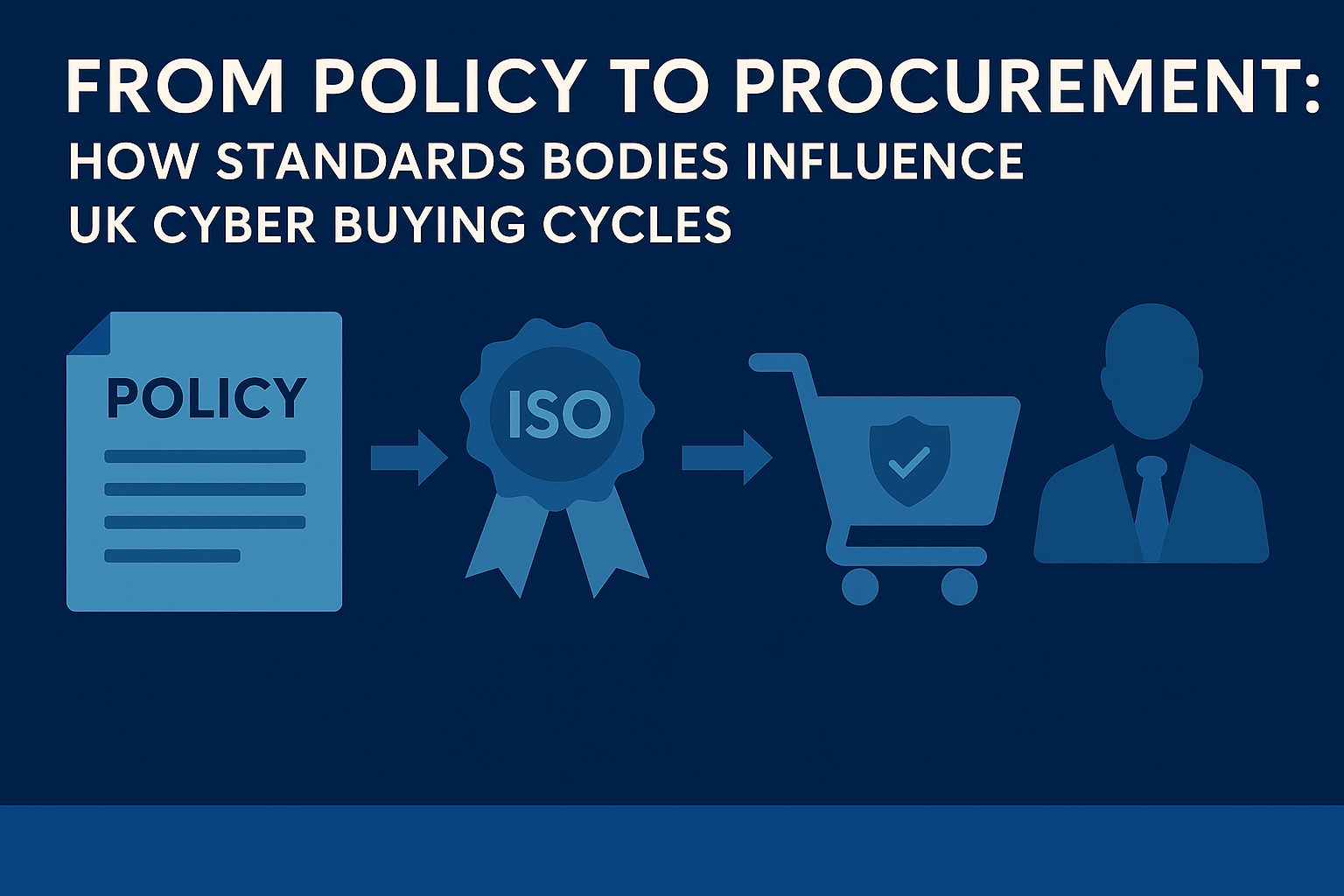It’s not just what’s secure, it’s what’s accepted, assured, and approved. Here’s how standards quietly determine what gets bought in cybersecurity. In cybersecurity, buying decisions are rarely made on features alone. Especially in the UK public sector and regulated industries, procurement is often shaped by frameworks, certifications, and official guidance issued (or heavily influenced) by standards bodies. These organisations, from NCSC and NIST to IASME, ISO, and CIISec, may not sell products, but they define the guardrails within which procurement happens. They help determine what “good” looks like, what qualifies as “secure enough,” and what’s required to win a bid. This article breaks down how standards bodies and frameworks influence what UK organisations actually buy, adopt, and fund when it comes to cybersecurity.
Contents
- Contents
- 1. The UK’s Cyber Standards Stack (And Where It Comes From)
- 2. How These Standards Shape Buying Behaviour
- 3. The Standards Bodies Driving the UK Market
- 4. The Procurement Lifecycle, and Where Standards Intervene
- 5. Shaping Influence Without Selling
- 6. What’s Emerging: Future Standards Influencing Buying
- Final Thoughts
- References
1. The UK’s Cyber Standards Stack (And Where It Comes From)
The frameworks that shape procurement are layered, often with overlapping authority:
- NCSC Guidance – Treated as definitive by most public sector and critical national infrastructure (CNI) organisations
- Cyber Essentials & IASME – Entry-level assurance, increasingly mandatory for supplier access
- ISO 27001 / 22301 / 27701 – Seen as baseline for mature organisations, especially those with international clients
- NIST CSF & SP 800 Series – Often used in global supply chains, especially in finance and defence
- CIISec Skills Framework – Quietly shaping who is considered ‘qualified’ for certain roles or services
2. How These Standards Shape Buying Behaviour
Bid Requirements
- “Must have ISO 27001” or “Cyber Essentials Plus required” appears in the majority of UK public sector cyber RFPs
- Organisations often filter vendors at pre-qualification stage using certifications
Architecture Alignment
- NCSC’s guidance on Zero Trust, logging, or cloud security directly informs solution architectures, and therefore product selection
Insurer-Driven Standards
- Insurers increasingly expect alignment with NIST CSF or MITRE ATT&CK frameworks
- Failure to adhere can raise premiums or invalidate cover post-incident
Procurement Frameworks
- Crown Commercial Service (CCS) frameworks (e.g. G-Cloud, DOS) require vendors to self-declare compliance with a host of frameworks
- The frameworks act as a barrier to entry, not meeting them = not being listed
3. The Standards Bodies Driving the UK Market
NCSC (National Cyber Security Centre)
- Their advice is not legally binding, but in practice, it is the national standard
- Especially influential in cloud, incident response, and resilience planning
- Key outputs:
- 10 Steps to Cyber Security
- Ransomware Response Playbook
- Zero Trust Architecture guidance
- Logging Made Easy
IASME Consortium
- Delivers Cyber Essentials and CE+
- Works with ~2,000 assessors and has shaped assurance expectations for SMEs and public sector suppliers
- Their scheme now defines the lower bound of what’s considered “secure” in UK supply chains
ISO / IEC
- 27001 (InfoSec), 22301 (Business Continuity), and 27701 (Privacy) dominate corporate assurance
- Required or heavily weighted in most regulated sector tenders (finance, healthcare, law)
CIISec (Chartered Institute of Information Security)
- Governs the Skills Framework for the Information Age (SFIA+) adaptation
- Increasingly used by HR, DSIT, and CCS to validate cyber qualifications and role suitability
- Also a founding member of the UK Cyber Security Council
NIST (National Institute of Standards and Technology, US)
- While American, NIST’s CSF, 800-53, and 800-171 have become global defaults
- Especially influential in:
- Multinationals with UK-US footprint
- Regulated procurement environments
- Post-incident improvements recommended by consultants and insurers
4. The Procurement Lifecycle, and Where Standards Intervene
| Stage | Influence Point |
|---|---|
| Pre-Tender | Standards used to scope the problem (e.g. align with NCSC cloud guidance) |
| Tender Drafting | Standards cited to define requirements (e.g. “must have CE+” or “align with NIST 800-53”) |
| Bid Evaluation | Certifications used to filter vendors or score maturity |
| Delivery | Standards used for progress tracking, compliance reporting, or contract enforcement |
| Audit / Renewal | Standards act as benchmark for review or renewal phases |
5. Shaping Influence Without Selling
For vendors, startups, or policy advocates, contributing to standards bodies offers route-to-influence without a sales pitch:
- Join TechUK, IET, or BCS working groups
- Become an assessor or advisory panel member for CE+ or CIISec
- Publish implementation guidance aligned to NCSC or ISO frameworks
- Map your product to existing assurance schemes (don’t reinvent the wheel)
6. What’s Emerging: Future Standards Influencing Buying
- Cyber Resilience Act (CRA) – EU regulation that will impact UK-based product suppliers
- DORA (Digital Operational Resilience Act) – Already shaping fintech procurement
- NCSC-Assured Skills & Training Schemes – Could influence which consultants/trainers get hired
- AI Risk and Assurance Frameworks – Where cyber and AI converge, expect NIST/NCSC-led structures to dominate
Final Thoughts
In the UK, the route from policy to purchase is paved with standards. They may seem dry, slow, or overly formal, but they act as the unspoken rulebook for what gets bought, who gets funded, and how security is measured.
Whether you’re a vendor, buyer, consultant, or policymaker, it’s clear:
If you’re not on the radar of the standards bodies, you’re not on the shortlist.
References
- Inside the UK Cyber Ecosystem: A Strategic Guide in 26 Parts
- The Insider’s Guide to Influencing Senior Tech and Cybersecurity Leaders in the UK
- From Policy to Procurement: How Standards Bodies Influence UK Cyber Buying Cycles
- The Quiet Power Players of UK Cybersecurity: Who Really Shapes the Agenda?
- Cyber Across Global Governments: International Cooperation and National Strategies
